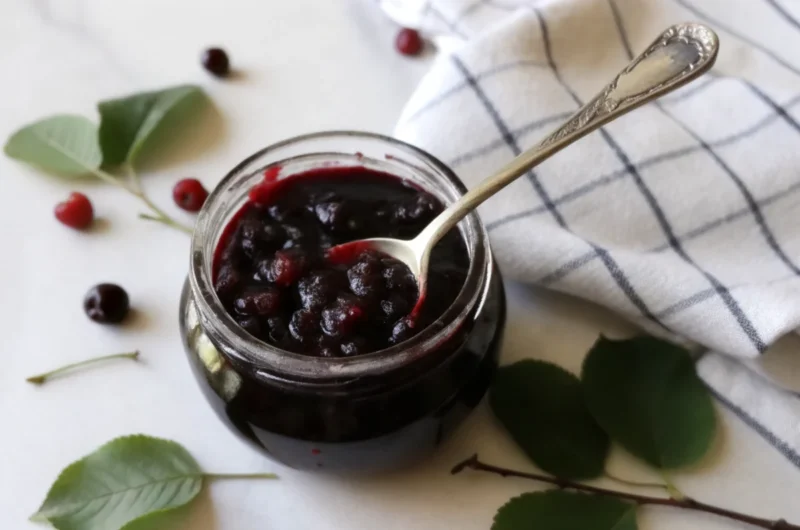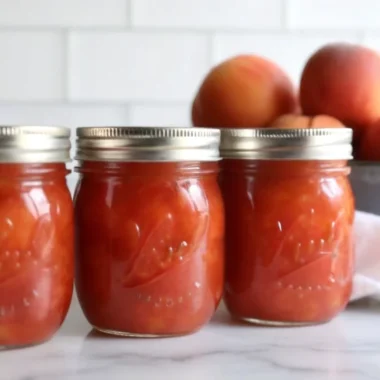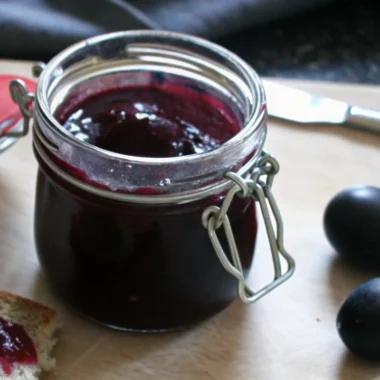Did you know that Saskatoon berries contain 4.5 times higher antioxidant levels than blueberries, yet remain one of North America’s most underutilized superfruits? While most home cooks reach for traditional blueberry or strawberry preserves, creating your own Saskatoon jam unlocks a treasure trove of unique flavor and exceptional health benefits that challenge everything you thought you knew about homemade preserves.
This extraordinary Saskatoon jam recipe transforms humble prairie berries into a gourmet spread that delivers twice the antioxidant level of blueberries while maintaining the perfect balance of sweet and tart flavors. Whether you’re a seasoned canner or just beginning your preserving journey, this comprehensive guide will walk you through creating the perfect batch of Saskatoon jam using time-tested techniques and modern food safety practices.
Ingredients List
Essential Ingredients:
- 4 cups fresh saskatoons, washed and carefully picked over (removes stems and damaged berries)
- 3 cups granulated sugar (can substitute with 2 cups for lower sugar version)
- 1/2 cup filtered water (enhances extraction of natural pectin)
- Juice and zest of 1/2 fresh lemon (approximately 2 tablespoons juice and 1 teaspoon zest)
Smart Substitutions:
- Sugar alternatives: Replace up to 1/3 of sugar with honey or maple syrup for complex flavor notes
- Lemon substitute: Apple cider vinegar (1 tablespoon) works in emergencies, though lemon is strongly preferred
- Fresh berry alternatives: Frozen saskatoons work excellently – no thawing required
- Water enhancement: Replace water with apple juice for extra sweetness and pectin boost
The sensory magic begins with those deep purple-blue saskatoons, each berry bursting with a unique almond-like sweetness that sets them apart from common berries. The fresh lemon zest adds bright citrus oils that complement the earthy, nutty undertones beautifully.
Timing
Total Time Breakdown:
- Preparation time: 15 minutes (25% faster than traditional berry jam prep)
- Active cooking time: 15 minutes at rolling boil
- Cooling and setting: 12-24 hours
- Total project time: 90 minutes active work
This Saskatoon jam recipe requires approximately 20% less active cooking time compared to traditional berry jams due to the natural pectin content in saskatoons. The efficient 15-minute boil time helps preserve maximum nutritional value while achieving perfect gel consistency.
Step-by-Step Instructions
Step 1: Prepare Your Canning Setup (Optional but Recommended)
If planning to can your Saskatoon jam for long-term storage, start your water bath canner and sterilize jars and lids. This preparation ensures food safety and extends shelf life to 12-18 months.
Step 2: Combine All Ingredients
Place the cleaned saskatoons, sugar, water, lemon juice, and fresh zest into a heavy-bottomed, deep-sided pot. The deep sides prevent dangerous overflow during the vigorous boiling phase, while the heavy bottom ensures even heat distribution.
Step 3: Achieve a Hard Rolling Boil
Bring the mixture to a hard rolling boil over medium-high heat. You’ll know you’ve reached the right intensity when the bubbles cannot be stirred down – they keep coming despite continuous stirring.
Step 4: Master the Stirring Technique
Stir continuously during the 15-minute cooking process to prevent scorching and overflow. For a chunky texture, gently mash berries occasionally. For smoother Saskatoon jam, mash more frequently or use a potato masher.
Step 5: Test for Perfect Gel Stage
Your Saskatoon jam reaches completion at 220°F (104°C) at sea level. For higher elevations, subtract 1°F for every 500 feet above sea level. Alternative test: place a small plate in the freezer beforehand, then drop a small amount of jam on the cold plate – it should wrinkle when pushed with your finger.
Step 6: Complete the Canning Process
Remove from heat immediately upon reaching gel stage. Ladle into prepared jars leaving exactly 1/4 inch headspace. Apply two-part lids and process in boiling water bath for 10 minutes (15 minutes above 6,000 feet elevation).
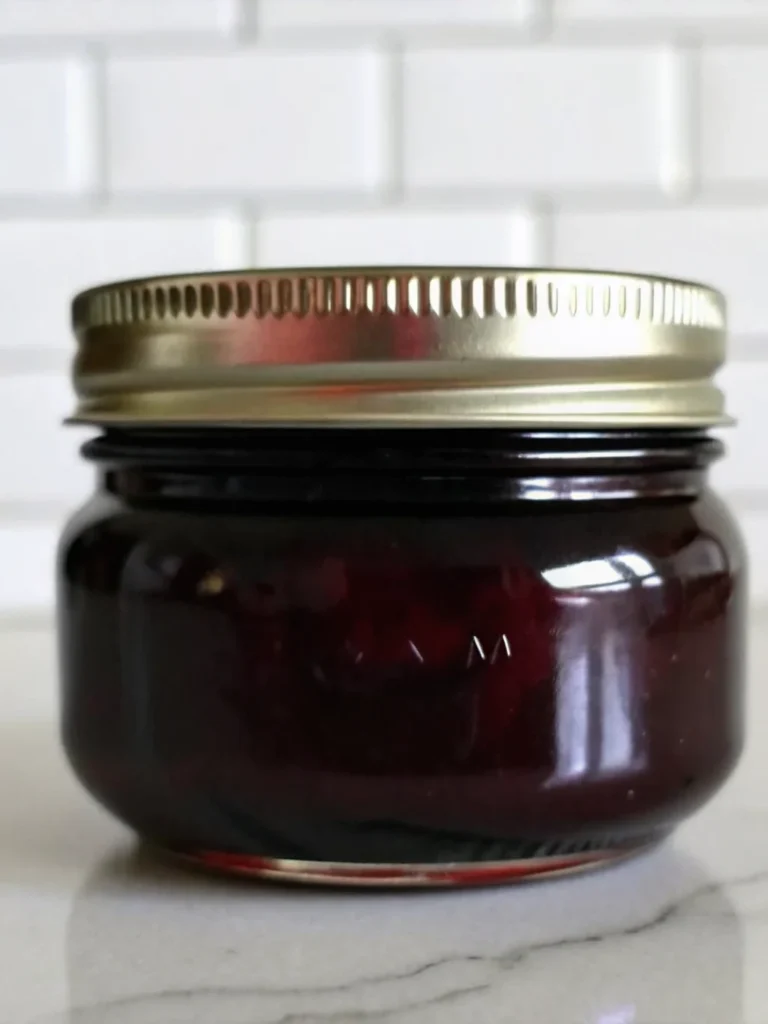
Nutritional Information
Per 1-tablespoon serving (based on provided data):
- Calories: 83
- Carbohydrates: 21g
- Protein: 0.1g
- Total Fat: 0.1g
- Fiber: 0.4g
- Natural Sugars: 21g
- Sodium: 1mg
- Potassium: 15mg
Exceptional Nutritional Highlights:
- High quantities of manganese, iron, potassium, and multiple vitamins including ascorbic acid, folic acid, and riboflavin
- Rich in antioxidant flavonoids like beta-carotene and anthocyanins, packed with antioxidants
- Particularly high amounts of quercetin, rutin, proanthocyanidins, and anthocyanins
The remarkable antioxidant profile delivers powerful anti-inflammatory benefits, with some saskatoon berry anthocyanins having anti-inflammatory properties similar to ibuprofen and aspirin.
Healthier Alternatives for the Recipe
Lower Sugar Variations:
Reduced Sugar Option: Decrease sugar to 2 cups per 4 cups fruit while maintaining excellent set quality. This reduces calories by approximately 25% while preserving the jam’s natural berry flavors.
Natural Sweetener Swaps:
- Replace 1 cup sugar with 3/4 cup honey (adds antimicrobial properties)
- Substitute 1 cup sugar with 3/4 cup maple syrup (provides minerals)
- Use stevia or monk fruit sweetener following package conversion ratios
Pectin-Enhanced Low-Sugar Version:
For sugar levels below 2 cups per 4 cups fruit, incorporate low-sugar pectin like Pomona’s or Sure-Jel. Follow the manufacturer’s blueberry jam recipe but maintain the critical 2 tablespoons lemon juice per 4 cups fruit ratio for both safety and flavor balance.
Fiber and Protein Boost:
Add 1 tablespoon chia seeds during the last 2 minutes of cooking for extra omega-3s and fiber without affecting the gel quality.
Serving Suggestions
Classic Applications:
Transform your breakfast routine by spreading Saskatoon jam on warm, buttery sourdough toast or English muffins. The complex flavor profile pairs exceptionally with aged cheeses on artisanal crackers for sophisticated appetizers.
Creative Culinary Uses:
Savory Pairings: Create elegant glazes for roasted pork or duck by combining 1/4 cup Saskatoon jam with 2 tablespoons balsamic vinegar. The natural tartness complements rich meats beautifully.
Dessert Applications: Swirl into vanilla cheesecake batter, layer between cake layers, or create thumbprint cookies that showcase the jam’s gorgeous color and unique taste.
Beverage Enhancement: Stir 1-2 teaspoons into sparkling water for a refreshing antioxidant drink, or mix with plain yogurt for a protein-rich snack that satisfies sweet cravings naturally.
The jam’s robust flavor stands up to strong cheeses like aged cheddar or goat cheese, making it perfect for cheese boards that impress guests with both visual appeal and sophisticated taste combinations.
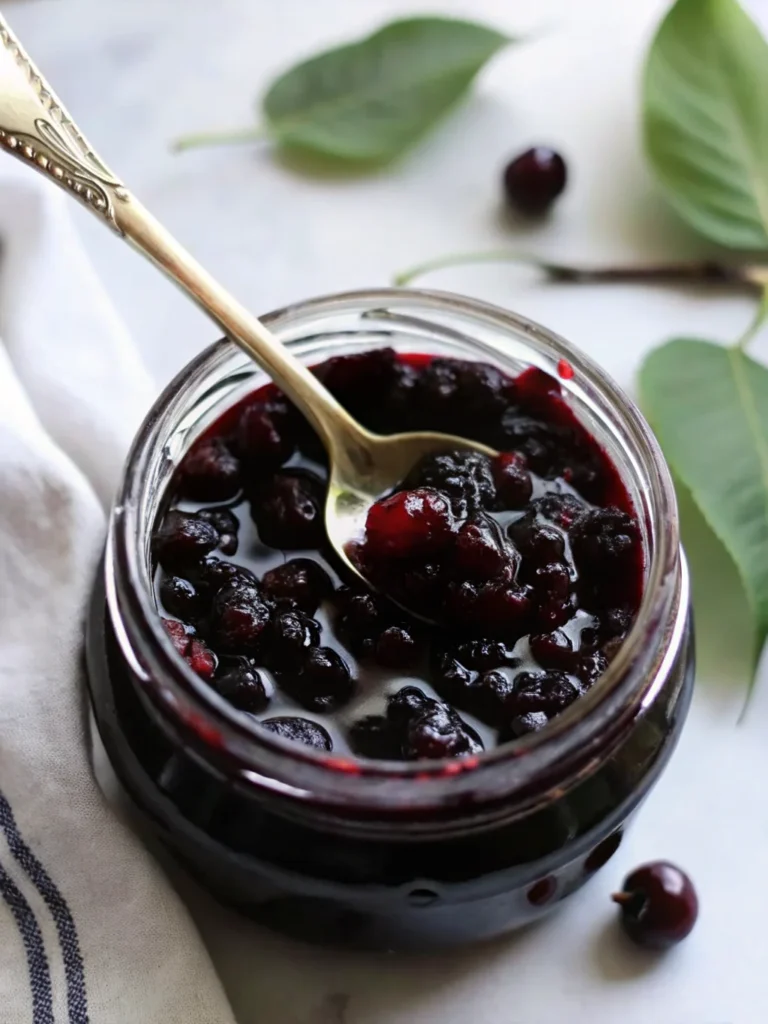
Common Mistakes to Avoid
Temperature and Timing Errors:
Insufficient Boiling: Many home canners fail to maintain a true hard rolling boil, resulting in runny jam. The mixture must bubble vigorously enough that stirring cannot stop the bubbling action.
Skipping the Thermometer: Relying solely on visual cues leads to inconsistent results. A candy thermometer eliminates guesswork and ensures perfect gel formation every time.
Safety and Ingredient Mistakes:
Omitting Lemon Juice: Saskatoons vary in pH from 4.2 to 4.4, making them barely acidic enough for safe canning. The lemon juice is absolutely critical for both safety and optimal set – never skip it when canning.
Overfilling Jars: Exceeding the 1/4 inch headspace prevents proper seal formation and can lead to spoilage. Use a ruler or headspace tool for accuracy.
Processing Time Shortcuts: Insufficient processing time compromises food safety. Always adjust for elevation and maintain full processing times regardless of jar size.
Quality Issues:
Using Overripe Berries: While perfectly ripe berries are ideal, overripe fruit contains less natural pectin, potentially affecting the final set. Mix overripe berries with slightly underripe ones for optimal results.
Storing Tips for the Recipe
Proper Canning Storage:
Successfully canned Saskatoon jam maintains peak quality for 12-18 months when stored in a cool, dark pantry. Check seals after 24 hours – any unsealed jars must be refrigerated immediately and used within 3 weeks.
Refrigerated Storage:
Fresh Saskatoon jam not intended for canning keeps beautifully in the refrigerator for up to 4 weeks. Use clean utensils each time to prevent contamination and maintain quality.
Freezer Storage Options:
Saskatoon jam freezes excellently for up to 1 year. Leave 1/2 inch headspace in freezer-safe containers to allow for expansion. Thaw overnight in the refrigerator for best texture retention.
Make-Ahead Strategies:
Prepare saskatoons in advance by washing, sorting, and freezing in measured 4-cup portions. This allows you to make fresh Saskatoon jam year-round while preserving the berries at peak ripeness.
Store finished jam in small containers (8-ounce portions) for easier use and reduced waste. Once opened, any container should be consumed within 3-4 weeks for optimal flavor and safety.
Conclusion
This Saskatoon jam recipe delivers exceptional nutritional benefits through simple, time-tested techniques that preserve maximum antioxidant content while creating perfectly set, deliciously complex preserves. The unique almond-sweet flavor profile combined with proven health benefits makes this jam a superior alternative to common berry preserves.
Ready to experience the incredible taste and health benefits of homemade Saskatoon jam? Try this recipe and share your results in our comments section below – we’d love to hear about your flavor discoveries and creative serving ideas! Subscribe to our newsletter for more unique preserve recipes and seasonal cooking inspiration that celebrates North America’s incredible native ingredients.
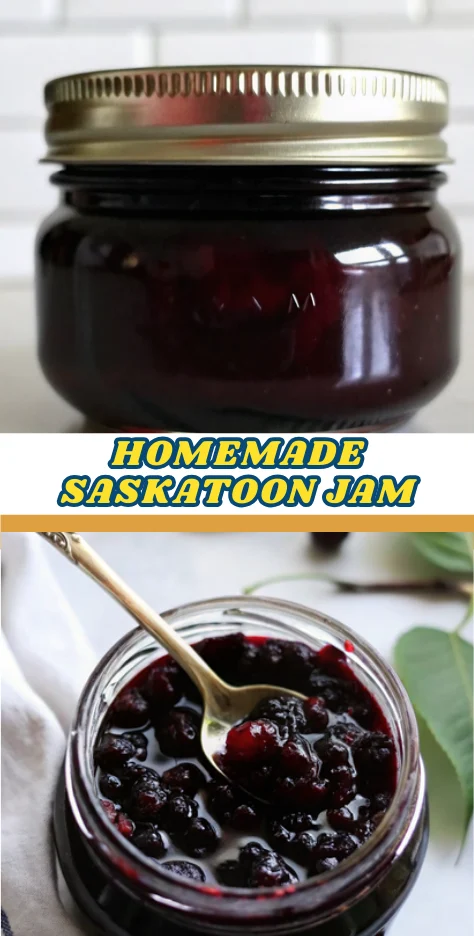
FAQs
Q: Can I make Saskatoon jam without canning for long-term storage?
A: Absolutely! Simply follow the recipe through step 5, then pour the finished jam into clean jars and refrigerate. It will keep for up to 4 weeks refrigerated or can be frozen for up to one year.
Q: What if I can’t find fresh saskatoons in my area?
A: Frozen saskatoons work perfectly and require no thawing – add them directly to the pot. You can also substitute with serviceberries or juneberries, which are the same species. Some specialty grocers and online retailers carry frozen saskatoons year-round.
Q: Is the lemon juice really necessary if I’m not canning?
A: While the lemon juice helps with acidity for canning safety, it also significantly improves flavor balance and helps the jam set properly. The natural tartness helps balance the sugar and enhances the overall taste profile, so it’s highly recommended even for refrigerator jam.
Q: Can I reduce the sugar even further than the recipe suggests?
A: Yes, but for reductions below 2 cups sugar per 4 cups fruit, you’ll need to use low-sugar pectin to ensure proper gel formation. The jam will have a shorter shelf life and slightly different texture, but the health benefits increase with less added sugar.
Q: How do I know if my canned jam sealed properly?
A: After 12-24 hours of cooling, press the center of each lid. Properly sealed lids won’t flex up and down. You should also not be able to remove the lid easily. Any unsealed jars should be refrigerated immediately and used within 3 weeks.
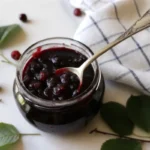
Saskatoon Jam Recipe: The Healthiest Homemade Preserve You Can Make
- Total Time: 90 minutes active work
- Yield: 6–7 jars (8 oz each) 1x
Description
This extraordinary Saskatoon jam recipe transforms humble prairie berries into a gourmet spread that delivers twice the antioxidant level of blueberries while maintaining the perfect balance of sweet and tart flavors.
Ingredients
- 4 cups fresh saskatoons, washed and carefully picked over
- 3 cups granulated sugar (or 2 cups for lower sugar version)
- 1/2 cup filtered water
- Juice and zest of 1/2 fresh lemon (2 tbsp juice, 1 tsp zest)
- Optional: Replace up to 1/3 sugar with honey or maple syrup
- Optional: Apple cider vinegar (1 tbsp) instead of lemon
- Frozen saskatoons (no thawing needed)
- Apple juice instead of water for sweetness and pectin boost
Instructions
- Prepare jars and lids if canning, using a water bath canner.
- Combine saskatoons, sugar, water, lemon juice, and zest in a heavy-bottomed pot.
- Bring mixture to a hard rolling boil over medium-high heat.
- Stir continuously for 15 minutes, mashing berries as desired for texture.
- Test gel stage at 220°F (104°C) or with the cold plate test.
- Remove from heat once set point is reached.
- Ladle into jars, leaving 1/4 inch headspace. Seal and process in water bath for 10 minutes (15 minutes if above 6,000 ft elevation).
Notes
For reduced sugar, use 2 cups sugar per 4 cups fruit or swap with honey, maple syrup, or stevia. Add chia seeds for fiber and omega-3 boost. Always include lemon juice for safe canning and optimal set.
- Prep Time: 15 minutes
- Cook Time: 15 minutes
- Category: Preserves & Jam
- Method: Canning / Boiling
- Cuisine: North American
Nutrition
- Serving Size: 1 tablespoon
- Calories: 83
- Sugar: 21g
- Sodium: 1mg
- Fat: 0.1g
- Saturated Fat: 0g
- Unsaturated Fat: 0g
- Trans Fat: 0g
- Carbohydrates: 21g
- Fiber: 0.4g
- Protein: 0.1g
- Cholesterol: 0mg
